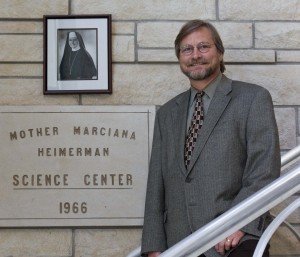
Science students, faculty and instruments are exceptional – now what about the facilities?
 Greetings from the Division of Science and Mathematics. These past few years have been an exceptional time for both the university and the math and science areas. The faculty has expanded, there are more students, and those students are enjoying real success after graduation. There is also more equipment, and the Heimerman science building got a cosmetic makeover last year.
Greetings from the Division of Science and Mathematics. These past few years have been an exceptional time for both the university and the math and science areas. The faculty has expanded, there are more students, and those students are enjoying real success after graduation. There is also more equipment, and the Heimerman science building got a cosmetic makeover last year.
In terms of faculty, Dr. Surendra Singh has completed 41 years of teaching, scholarship and mentoring students at Newman University. Dr. Stacy Jones has earned tenure, and Susan Orsbon received the 2010-11 Teaching Excellence Award. That brings the total to six such awards to the sciences, and every member of the Biology and Chemistry Departments who has been here more than three years has earned that distinction!
Last year the department welcomed Dr. Michael Bradley as assistant professor of biology. John Vogt, Dr. Lori Steiner and Barbara Sponsel still embody the excellence of the Math Department, with Barbara nearing completion of her Ph.D. In the Chemistry Department, Dr. John Leyba, Dr. Renee Hein, and yours truly welcomed Alan Oberley as lecturer of chemistry and lab coordinator. Alan comes to Newman with a distinguished teaching record from Kapaun Mt. Carmel High School.
The students and their achievements are a distinct matter of pride for the division. This year, General Biology has 90 students enrolled, and General Chemistry has more than 70.
I am pretty sure you’ve heard about the record number of NU students accepted to KU Medical School last year (SEVEN!), and the good news continues. This summer, Caleb McCormick and Cooper Stewart were accepted into the Scholars in Primary Care Program at KU Med School. This highly competitive program guarantees medical school admission to sophomore students interested in practicing primary care medicine, especially in rural Kansas. Eleven Newman students have been accepted, more than any other college in the state except KU and K-State, which last year had 21 and 36, respectively.
The instrumentation in the math and science areas continues to improve. Last year, the Chemistry Department purchased a replacement gas chromatograph-mass spectrometer, and just two years ago replaced the aging gas chromatographs with a capillary FID instrument and replaced an ailing FT infrared spectrometer. This year, chemistry will invest in computer-interfaced instruments that will allow students virtually one-on-one access to pH meters, colorimeters and spectrometers. The biology holdings also continue to improve, with the acquisition of computer-interfaced physiology instruments and biotechnology equipment. The Mathematics Department has purchased a smart board, increasing the level of both technology and interactivity in the math classrooms.
Finally, last year the Chemistry Club, which has won the Club of the Year award for the past two years, completed a mural project on the interior walls of the science building. While the building lacks many features now considered essential for a modern facility – such as ventilation – it now has a very colorful and engaging interior, with murals of geologic time, a periodic table, and a meticulous drawing of the inside and outside of a grasshopper (I’d bet that brings back memories of General Biology!).
The circular staircase has also been adorned with a mural of a strand of DNA. If you translate the base code in that strand, you obtain a protein that is painted on an adjacent wall, namely arginylglutamyltryptophanylmethionylalanylarginine. Of course, it is more fun to use the one letter abbreviations for this hexapeptide: N-E-W-M-A-N. This clever secret code was entirely the work of the students.
While this “makeover” may reflect the spirit of today’s youth, the fact is that the Heimerman Science Center was built in 1966. There are no dedicated labs for student-faculty research, the lack of adequate ventilation precludes many types of experiments, and the building is not ADA compliant. The plumbing and electrical service is grossly inadequate, to the point that students occasionally have to work in “shifts” to complete an experiment. And, in case you’ve not heard me point this out recently, there are no windows.
As you can see, the math and science area has excellent students, faculty and instrumentation. Students are achieving high levels of academic performance while at Newman, as well as high levels of success after graduating. Imagine what would be possible with a modern facility to replace Heimerman.
Tags: Alan Oberley, Barbara Sponsel, Biology, Caleb McCormick, Capiallary FID Instrument, Chemistry, Cooper Stewart, Division of Science and Mathematics, FT infared spectrometer, Gas Chromatograph-mass Spectrometer, General Biology, General Chemistry, Heimerman Science Building, John Leyba, John Vogt, Kansas, Kansas State University, Kapaun Mt. Carmel Catholic High School, Lab Coordinator, Lori Steiner, Mathematics, Michael Bradley, Newman University Teaching Excellence Award, Renee J. Soukup-Hein, Scholars in Primary Care Program, Stacy Jones, Surendra Singh, Susan Orsbon, University of Kansas, University of Kansas School of Medicine
